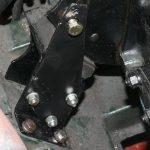Introduction to tuning
All pre-electronic MG engines are easy to tune and hold no great mysteries, so are easy for owners who want to do their own maintenance to tackle if they go about it methodically and in the right sequence.
Generally, if you give your car a thorough tune-up when you buy it, and then tune your car at regular intervals thereafter you will find that you need only to sort the ignition (replace spark plugs, points, condenser and set the ignition timing) and then check the carburettor settings (which usually don’t change by much if at all).
The following comments provide an overview to tuning, with more detailed comments on various aspects covered on other pages.
The vital golden rules:
- If you have a problem, do one thing at a time – that way you get to understand what has happened, and more importantly can undo any step which had a perverse effect.
- Do the ignition first. I cannot repeat this enough!
- Contrary to popular myth, any problem will NOT usually be with the carburettors! (This rule is also known as “Before touching the carburettors, make sure everything else is right first.”)
The initial thorough tune-up:
By thorough tune-up, I mean that before undertaking the usual checks for ignition and carbs you ensure the following are all in good condition:
- Distributor – should advance at the correct rate and should not be excessively sloppy in the bearings or drive. Distributor cap and rotor should be in good order.
- The cylinders are holding pressure – no significant leakage in the valves or rings – see compression testing, below.
- Carburettors – should not be floppy in the throttle spindles and should not be worn significantly in the jets or jet needles. The needle valves should shut off properly and the float should be at the right position when it does so.
It is impossible to properly tune an engine properly which has faults in any of these areas. If any are present, expect only limited results until they are addressed.
Having checked these items, you then need to also check:
- The spark plug leads. If in doubt, replace them.
- The tappets are set correctly
- There are no air leaks into the intake system. A quick visual check is all that is needed initially. However, remember this as a potential cause of puzzling problems.
Distributor condition
The advance mechanisms are covered on other pages on this site.
Sloppiness in the distributor or its drive causes the timing to flutter around, or “scatter”. This effect will be readily seen if you uses a strobe light to look at the timing marks on the crank pulley. The mark should, ideally, be very steady rather than be jumping about.
In reality, with mechanical distributors some movement usually occurs other than if everything is freshly renewed. A couple of degrees is not unusual and while not ideal is still acceptable. Any timing scatter of more than 5 degrees should be followed up. I have seen up to 20 deg in bad cases!
Unfortunately, remedies for timing scatter are not cheap or simple, and come down to either a full distributor overhaul (or new distributor) and/or a new camshaft & distributor drive spindle. However, if scatter is bad you will be well rewarded with both power and economy if it is fixed.
The most common cause of timing scatter in B series engines is wear in the gears which drive the distributor, especially the one on the camshaft since the oil pump is also driven by this. (A series suffer from this too, but not anywhere near as frequently as the oil pump drive is elsewhere.) For this reason, always check this potential source of scatter before assuming it is the distributor bearings etc worn. To check without removing the camshaft, remove the distributor and see if there is significant backlash in the drive spindle. (Note: backlash can also be caused by the use of a gasket between the distributor mounting fitting and the block, as it allows the spindle to float axially.)
Compression testing
If you haven’t encountered this term before, in this context it refers to measuring the maximum pressure in the cylinder while the engine is cranking over on the starter (with the ignition disabled so the car doesn’t start)
Check the compressions if:
- it is a new (to you) car – if this wasn’t already done prior to purchase
- the car has been unused for some time (months, not weeks) as this can cause rusting on the valve seats and consequent lack of sealing
- it is some time since you have done one and there is an unusual or elusive problem
Compression testers are relatively cheap (cheaper to buy a gauge than to drive in and pay someone to do the job). Their instructions, or workshop manuals, outline how to use and interpret them. The only comments I will add are:
- if you can’t find the correct cranking compression pressures listed for your car, work on 20 times the compression ratio as the figure for a good healthy engine. (For example, 8.8:1 should give about 20 x 8.8 = 176 psi on the compression gauge).
- in the absence of any data from the manual, the best indication of condition is that the compressions between different cylinders don’t vary by more than 10 psi.
- the actual compression readings will vary from those in the manual if the engine is modified.
A simple approximate compression check is to crank the engine over with the plugs in but ignition disconnected, and listen to the beat of the engine. It should be even. To hear what very “uneven” sounds like, remove a spark plug and crank it again (listen to the beat, not the whoosh of air in and out of the plughole).
Air leaks
As noted above, air leaks in the inlet tract can be the source of an elusive problem. Some sources are:
- The gasket between manifold and head. In particular, the A series manifold gasket is very thin above and below the inlet ports and fails at this point relatively easily.
- Cracks in the heat shield which extend into the join between carb and manifold
- Faulty brake booster (if fitted). To eliminate this as a source, disconnect the vacuum hose from the manifold to the booster and plug it off.
- Faulty PCV valve on mid-late 60’s B’s and Midgets. This can be accompanied by excessive oil consumption.
- Carburettors or manifold loose. Unusual, but yes, it can happen!


